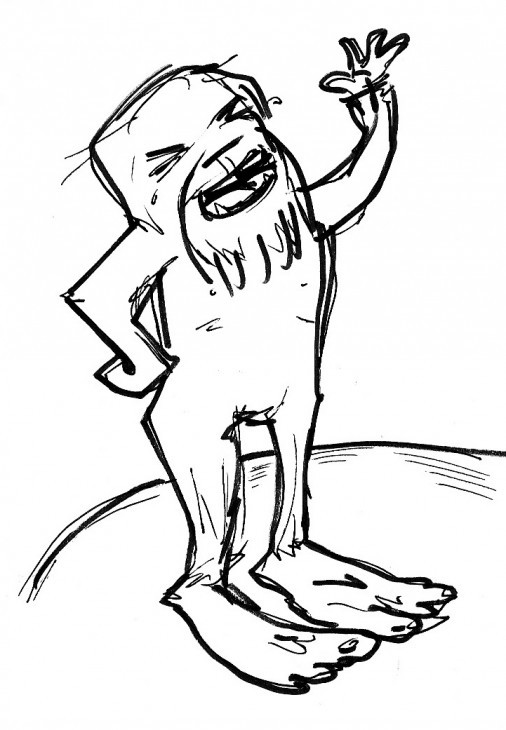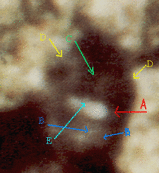 Happy 200th birthday to you, Bigfoot, you hairy, reclusive, and almost certainly non-existent creature!
Happy 200th birthday to you, Bigfoot, you hairy, reclusive, and almost certainly non-existent creature!
Call it the Bicentennial of Baloney if you will, but today is the 200th anniversary of the first modern-day sighting of Bigfoot in the Americas.
Stories of a supersize human-like beast go back for centuries all over the world — Tales of the Yeti, as Armistead Maupin might say. But we’re talking about “our” Bigfoot: the one who lives in North America, gambols through evergreens, looks back over his shoulder at the camera, and scares the dickens out of Cub Scouts at night.
That Bigfoot goes back to January 7, 1811. On that day, Canadian explorer David Thompson recorded these words in his daily journal while pioneering through what is now Alberta, Canada:
[In the snow] I saw the track of a large Animal – has 4 large Toes abt 3 or 4 In long & a small nail at the end of each… The whole is about 14 In long by 8 In wide & very much resembles a large Bear’s Track.”
14 inches long by 8 wide!
Thompson was no crank. On that same trip he completed the first official survey of the Columbia River, and he compiled “meticulous field and survey notebooks, sheets of watercolors, letters describing the state of the interior during the period of contact, and maps of western North America.” His word is good.
 But Thompson didn’t claim he actually saw a Sasquatch, either. The Indians and other men of his party thought the mystery prints were from a “young mammouth” and Thompson said he felt it was a “large old grizzly bear.” But his party “made no attempt to follow this beast, for what could the balls of our fowling guns do against such an animal?”
But Thompson didn’t claim he actually saw a Sasquatch, either. The Indians and other men of his party thought the mystery prints were from a “young mammouth” and Thompson said he felt it was a “large old grizzly bear.” But his party “made no attempt to follow this beast, for what could the balls of our fowling guns do against such an animal?”
Sasquatch has popped up since then many times, many ways, but there are really two other key dates in the modern Sasquatch saga:
1958: Scary giant tracks are discovered at a logging work site at Bluff Creek, California. The workers take plaster casts and dub the creature “Bigfoot” — the first actual use of the name. The story is reported in the local paper, the Humboldt Beacon, and becomes international news.
1967: Two men named Roger Patterson and Robert Gimlin release film of what they say is an actual female Bigfoot, taken on October 20th near the same logging camp where the 1958 prints were found. This is the famous fuzzy “Patterson film” you’ve probably seen, with the beast striding away through the forest and casting her inscrutable Garbo-like glance at the camera.
Those two events kicked off the “does Bigfoot exist?” frenzy of the 1960s and 1970s. But in truth, nobody gives much credit to either incident any more.
One of the 1958 loggers, Ray Wallace, made hay out of the incident for decades, even offering one million dollars in 1998 to anyone who brought him a baby Bigfoot. But when Wallace died in 2002, his family admitted that he had made the prints himself using carved wooden feet. His son said, “The reality is, Bigfoot just died.”
 The Patterson film just looks silly on the face of it now. Scientists and expert amateurs have made many practical points against it — for instance, the Bigfoot shown has hairy breasts, and that isn’t standard equipment for female primates. The face is all wrong, and so on. The Georgia gorilla-suit hoax of 2008 didn’t help things.
The Patterson film just looks silly on the face of it now. Scientists and expert amateurs have made many practical points against it — for instance, the Bigfoot shown has hairy breasts, and that isn’t standard equipment for female primates. The face is all wrong, and so on. The Georgia gorilla-suit hoax of 2008 didn’t help things.
Still, nobody has 100% proved that the 1967 film was a fraud. Roger Patterson died in 1972, without making a deathbed confession of any sort; Robert Gimlin lives on and insists that the film was real.
But honestly.
Anyway, it’s not the lack of credible video that makes scientists doubt Bigfoot. It’s the lack of any other sign that he’s been around the forest. As the Skeptic’s Dictionary puts it, “no bones, no scat, no artifacts, no dead bodies, no mothers with babies, no adolescents, no fur, no nothing.”
These days Bigfoot is reduced to cheering for sports teams and selling beef jerky. The 2010 Vancouver Olympics emasculated the poor guy, reducing him to “a shy and gentle giant that loves all winter sports, and is especially fond of hockey and dreams of becoming a world-famous goalie.” That’s harsh.

Not that everyone has given up. The Humboldt Beacon — the same paper that broke the Bigfoot story in 1958 — reported last summer on an eager-beaver new researcher named William Barnes. He told the paper he’d be “the first in history to utilize remote-controlled blimps with on-board thermal imaging cameras and high-tech audio equipment” to find Bigfoot.
Good luck, Mr. Barnes! And happy 200th birthday, Bigfoot, wherever you’re hiding.
(Original Bigfoot illustrations by Paul Hehn for Who2.)
